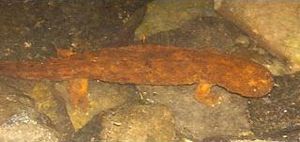Cryptobranchoidea facts for kids
Quick facts for kids CryptobranchoideaTemporal range: Jurassic - Recent
|
|
|---|---|
 |
|
| A giant salamander, Cryptobranchus alleganiensis | |
| Scientific classification | |
| Kingdom: | |
| Phylum: | |
| Class: | |
| Subclass: | |
| Order: | |
| Suborder: |
Cryptobranchoidea
|
| Family | |
|
|
Cryptobranchoidea (say "Krip-toe-bran-KOY-dee-uh") is a special group of salamanders. These amazing creatures are sometimes called "primitive salamanders." This means they have some features that are very old, like their ancestors from millions of years ago. You can find them living in different parts of the world, including eastern North America, China, Taiwan, and Japan. They are different from "advanced salamanders," which belong to another group called Salamandroidea.
Contents
What are Primitive Salamanders?
Salamanders in the Cryptobranchoidea group are called "primitive" because they keep some traits that their very old ancestors had. For example, most salamanders in this group lay their eggs in water. The male then fertilizes the eggs outside the female's body. This is different from many other salamanders.
Another interesting thing about some of these salamanders is how they breathe. Many can breathe through their skin! They also have special folds of skin that help them take in more oxygen from the water.
Where Do They Live?
These ancient salamanders are found in specific parts of the world.
- In eastern North America, you can find the giant salamanders.
- In Asia, they live in countries like China, Taiwan, and Japan.
They prefer cool, clear water in rivers and streams.
Families of Cryptobranchoidea
Today, there are only two main families of Cryptobranchoidea that are still alive. Many other families went extinct a long time ago. We only know about those extinct families from their fossils.
Giant Salamanders (Cryptobranchidae)
This family includes some of the largest salamanders in the world! They are truly giants.
- The Chinese giant salamander can grow to be almost 6 feet (1.8 meters) long.
- The Japanese giant salamander is also very large.
- The Hellbender lives in North America and is smaller, but still big for a salamander.
These giant salamanders spend almost all their lives in the water. They have flat bodies and heads, which helps them hide under rocks. They are mostly active at night, hunting for fish, frogs, and insects.
Asiatic Salamanders (Hynobiidae)
This family is found only in Asia. They are generally smaller than the giant salamanders.
- Most Asiatic salamanders lay their eggs in water.
- Some species live mostly on land as adults.
- They often have small lungs and breathe through their skin and mouth lining.
These salamanders are important parts of their ecosystems. They help control insect populations and are a food source for other animals.

